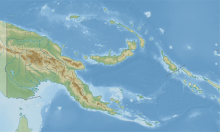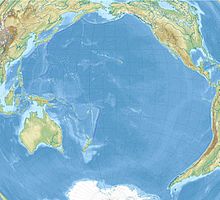| Battle of Cape Gloucester | |||||||
|---|---|---|---|---|---|---|---|
| Part of the Pacific War of World War II | |||||||
 US Marines hit three feet of rough water as they leave their LST to take the beach at Cape Gloucester, New Britain, 26 December 1943. | |||||||
| |||||||
| Belligerents | |||||||
|
| |||||||
| Commanders and leaders | |||||||
| Units involved | |||||||
| 4th Shipping Group | |||||||
| Casualties and losses | |||||||
|
310 killed 1,083 wounded | 2,000 killed | ||||||
Location within Papua New Guinea | |||||||
The Battle of Cape Gloucester was fought in the Pacific theater of World War II between Japanese and Allied forces on the island of New Britain, Territory of New Guinea, between 26 December 1943 and 16 January 1944. Codenamed Operation Backhander, the US landing formed part of the wider Operation Cartwheel, the main Allied strategy in the South West Pacific Area and Pacific Ocean Areas during 1943–1944. It was the second landing the US 1st Marine Division had conducted during the war thus far, after Guadalcanal. The objective of the operation was to capture the two Japanese airfields near Cape Gloucester that were defended by elements of the Japanese 17th Division.
The main landing came on 26 December 1943, when US Marines landed on either side of the peninsula. The western landing force acted as a diversion and cut the coastal road near Tauali to restrict Japanese freedom of movement, while the main force—landing on the eastern side—advanced north towards the airfields. The advance met light resistance at first but was slowed by the swampy terrain which channeled the US troops onto a narrow coastal trail. A Japanese counterattack briefly slowed the advance, but by the end of December the airfields had been captured and consolidated by the marines. Fighting continued into early January 1944 as the marines extended their perimeter south from the airfields towards Borgen Bay. Organized resistance ceased on 16 January 1944 when marines captured Hill 660; however, mopping up operations in the vicinity continued into April 1944 until the marines were relieved by US Army forces.

